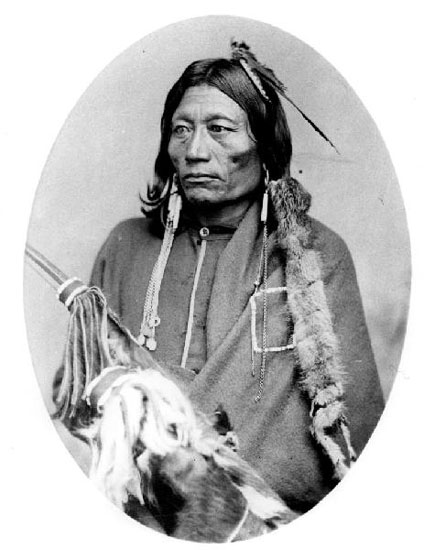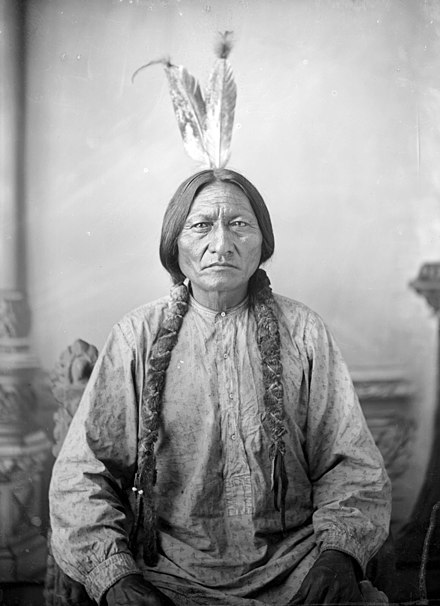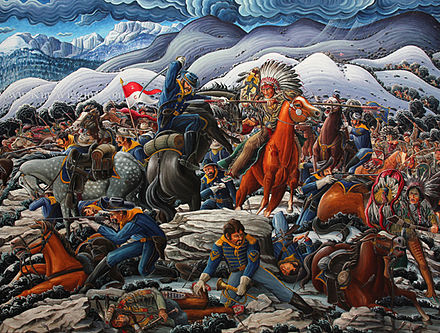 Tribe
Tribe: Crow
Territory: Wyoming, Montana, North Dakota
Current Status: Still around
Population (approx): 14,000
Enemies of the Cheyenne and Sioux, but allies of the Apache, the Crow became breeders of horses and thus the target for horse raids by, among others, the Blackfoot. They, too, hunted the bison, originally on foot and, somewhat like the Cheyenne, disguised, though with wolf pelts rather than those of buffalos. They killed the buffalo with spears and lances. Later of course they used horses and the hunts were much more successful and efficient. They lived in teepees and, though I can’t confirm if they were the only ones, they’re the first ones I’ve heard of who actually used fires inside the tent. Doesn’t sound very safe, but they appear to have done it anyway.
There was no sexual ambiguity among the Crow, unlike some of the other tribes we’ve read about. Men literally wore the trousers (breeches or leggings) and women wore dresses. Men wore their hair much longer than the women, sometimes being in danger of tripping over it! They also often wore it in the pompadour style, coloured white with paint. They could theoretically have been called the Bead People, as just about everything they had, from costumes to horses to teepees were decorated with beads, and they knew the importance of colour and its significance, reflecting this in the face and body paint they wore, and in the tattoos also.
 Tribe
Tribe: Apache
Territory: Texas, Oklahoma, Arizona, Mexico, Colorado
Current Status: Still around
Population (approx): 111,810
A by-word and catch-all term for “Indians” in western movies, Apache are probably the best-known of the Native American plains tribes, and actually comprised more than a dozen tribes affiliated with them. Historically they tended to live in high mountains, valleys and deserts and canyons. They are related to the Athabaskan peoples whom we met in the far colder climes of the Arctic. Very much nomadic, the Apache did not leave much behind archaeologically speaking to denote how they lived, but we do know they were a closely-linked community, living together and the tradition being if a man’s wife died that he married her sister, and if a woman’s husband died then her brother was expected to take over. How that worked if he was already married I don’t know, but most Native American tribes seemed not to have a problem with polygamy, so maybe it was just that, two wives.
Chiefs were chosen if they fulfilled the main criteria: industriousness, impartiality, generosity, forbearance, conscientiousness and eloquence in language. Oddly enough, for a warrior people, courage or honour or prowess in battle does not seem to have figured in the requirements for choosing a leader. Within the Apache culture all tribes were autonomous and independent, and certain tribes even fought against each other. Apache lived in three different types of dwelling, depending on the territory. Plains natives lived in teepees, those in the mountains and highland regions in a domed structure called a wickiup (sound like the research I do!) and the desert tribes preferred a hogan, which was an earthen dwelling which helped them keep cool.
Although the Apache hunted various animals, to some of the tribes certain of these were taboo, and not to be consumed. Among these were bear, turkey, coyote and owls. Apache used bow and arrow to hunt, and also whistles to lure their prey. The most famous Apache of all, and indeed one of the most famous Native Americans, was of course Geronimo, but we will meet him a lot later into this history.
Tribe: Conoy or Piscataway
Territory: Maryland, Virginia
Current Status:: Still around
Population (approx): 4,103
Another of the more permanent tribes, the Conoy were not hunter-gatherers but farmers, though they hunted of course for their food - wolves, bear, elk, deer, squirrels, beavers, turkey and more were their quarry. They lived in long houses protected by a wooden palisade, and they fished in the nearby rivers as well as using canoes to navigate them.
Tribe: Erie
Territory: Pennsylvania
Current Status:: Extinct
Population (approx): 0
After a hard and brutal war with the Iroquois, the Erie people’s villages were burned, which destroyed their stores of maize and eventually led to their total extinction.
 Tribe:
Tribe: Ho-Chunk (including Winnebago):
Territory: Wisconsin, Iowa, Illinois, Nebraska, Minnesota
Current Status:: Still around
Population (approx): 7,000
They were a hunter-gatherer people who followed the source of food, hunted and fished and used the local plants in their medicine. Like most Native American tribes, they did not just eat the game, but used its skin for coverings for their houses, for clothing and for making tools. They also followed the practice of Vision Quest, for the young boys, a rite of passage. Although now patrilineal, the Ho-Chunk are believed to have been originally matrilineal and they also practiced the custom of marrying outside of their clan, of which there were originally twelve, each associated with a spirit animal such as buffalo, eagle or bear.
 Tribe
Tribe: Navajo
Territory: Arizona, Utah, New Mexico
Current Status: Still around
Population (approx): 399,494
Related both to the Apache, and therefore the Athabaskan people, the Navajo are another matrilineal tribe, with property passing down the mother’s line to the wife, and she retaining the children by law if the parents separate. In the reverse of western tradition, a man intending to get married is expected to bring money, property or other forms of wealth in what is called bride wealth. The Navajo appear to be unique (at least, in what I’ve read so far) in building specific types of different dwellings, or hogans, for men and women. A male hogan is square or conical with a rectangular entrance, while the hogan of the female has eight sides. They are built of logs covered in mud, the entrance always facing east, to welcome the sun in the morning. The hogan is sacred and goes all the way back to their beginnings, when the Navajo trickster god Coyote is said to have built the first one for the First Man and First Woman.
Navajo belief seems to be centred around the idea of nomadism, of moving on; they teach that they began in one world, had to transition through two more before arriving here, in the fourth world. They strive to maintain the balance between man and nature, creating harmony in their own lives through their efforts. Like many of the tribes they perform dances as part of their ritual ceremonies, including the Night Chant, which is used to help people back to health.
 Tribe
Tribe: Sioux
Territory: Minnesota, Wisconsin
Current Status: Still around
Population (approx): 170,110
Another extremely famous tribe, not least due to the great chief Sitting Bull, who defeated General Custer at the Battle of the Little Big Horn, the Sioux are in fact a Nation, made up of two major divisions, the Dakota and the Lakota. They see the natural and supernatural world as very much linked, and important to each other, and teach that all things must be accorded the same respect.
"We should understand well that all things are the works of the Great Spirit. We should know that He is within all things: the trees, the grasses, the rivers, the mountains, and all the four-legged animals, and the winged peoples; and even more important, we should understand that He is also above all these things and peoples. When we do understand all this deeply in our hearts, then we will fear, and love, and know the Great Spirit, and then we will be and act and live as He intends" - (Black Elk, The Sacred Pipe: Black elk’s Account of the Sacred Rites of the Oglala Sioux)
Kind of sounds like where Lucas may have got the idea for the Force, doesn’t it? Prayer and dreams can both invoke the spiritual world, and allow the Sioux to call upon their ancestors for aid or wisdom. Dreams were also believed to have the power to confer supernatural abilities on the dreamer. The ruling body of the Sioux was known as the Seven Council Fires, and they met in summer to discuss policy, choose new leaders, hear disputes and also to renew kinships between the tribes, which was a central tenet of their civilisation, in fact the most important. Leaders were chosen based on a mixture of virtues including bravery, fortitude, generosity and wisdom, and also based on their lineage.
The Sioux also had warrior societies, some of them used to train young warriors, some used as a sort of internal police force. Their burial practices were different from other tribes: they did not bury their dead but put the body on a platform raised over the ground, along with their personal effects, and mourned them for a year, speaking to the corpse as if it were still alive and offering it food. Must have got pretty rank after a few months, never mind a year! The body was always placed with its head towards the south, and the Ghost Dance was performed to aid the progress of its soul into the afterlife. Only if the person had been a victim of murder would they be placed directly in the ground. Perhaps they didn’t think someone who allowed himself to be murdered was likely to get into the afterlife? I really don’t know. Maybe it was seen as a sign of disgrace, to let your guard down and not die honourably in battle?
I’m sure I don’t need to tell you, but the most famous names we know in Native American history come from the Sioux: Red Cloud, Crazy Horse and of course Sitting Bull.
Tribe: Honniasont
Territory: Pennsylvania, Ohio, West Virginia
Current Status:: Extinct
Population (approx): 0
Nothing I can tell you about these guys.
Tribe: Unami (including Acquackanonk, Okehocking and Unalachtigo)
Territory: Delaware, New Jersey, Pennsylvania
Current Status:: Extinct
Population (approx): 0
Not much information on these lads at all.
Tribe: Manahoac
Territory: Virginia
Current Status:: Extinct
Population (approx): 0
They were allies of the Monacan but not of the Powhatan, and buried their dead in burial mounds or barrows, unlike a lot of other tribes who tended to either bury corpses as they were or strip them of flesh and organs and then just cover the grave with a board. These burial mounds were not just for one person, but have been found with the remains of hundreds, even thousands of corpses inside. Hunter-gatherers, they lived along rivers and fished and farmed.
Tribe: Mascouten
Territory: Michigan
Current Status:: Extinct
Population (approx): 0 (There are descendants but they have been absorbed into the Kickapoo tribe)
Other than that they were called the Fire Nation, shrug.
Tribe: Massachusett
Territory: Massachusetts, duh!
Current Status:: Still around, barely
Population (approx):150
Occupying some of the most fertile and flat land in New England, the Massachusett were of course farmers as well as hunters.
Tribe: Meherrin
Territory: Virginia, North Carolina
Current Status:: Still around
Population (approx): 900
Connected to the Iroquois League and related to the Tuscarora.
 Tribe
Tribe: Arapaho
Territory: Colorado, Wyoming, Minnesota, Montana, Nebraska, Oklahoma, Kansas
Current Status: Still around
Population (approx): 10.861
The Arapaho, like many or most of the tribes of the plains, centred around the notion of the warrior and had warrior societies, with leaders elected according to the ancient practice of counting coup, explained earlier. They decorated their bodies and horses with war paint, each warrior choosing his own personal colour and pattern which was specific to him and held special significance for him. They were enemies to, among (many) others, the Blackfoot, Pawnee, Navajo, Apache and Crow. They also fought against the Cheyenne and Sioux, but later became their allies.
Although their gender roles are set along traditional lines - men being hunters and warriors, women staying at home with the kids and doing the cooking etc - the Arapaho have a third gender, called
Haux’xan or Two Spirit, which seems to conform to the modern idea of a woman born in a man’s body. These are not seen as freaks, rather, as divinely-touched beings with supernatural powers, and highly revered. There does not seem to be a female-to-male contemporary though. The
Haux’xan assume the responsibilities and roles of women, dress like them and - oddly enough - are allowed/expected to marry men. Whether that indicates an acceptance of homosexuality in this tribe or not I really can’t say, though you can’t imagine any other way this would be accomplished. Perhaps, if the
Haux’xan are seen as female in the eyes of males, they become so in their minds?
************************************************** *******
This is just supposed to be a small, representative sampling of some of the major (and a few minor) tribes of peoples who inhabited what would come to be known as America in the early period before Columbus. Of course there are hundreds of tribes and nations left out, but this isn’t intended to be the history of Native Americans, and the actual history of America itself is a huge undertaking, so we need to get to that without too much delay. I nevertheless wanted to be sure not to simply dive in at the discovery of America (or, as he believed it, the West Indies) by an Italian explorer as the starting point for the history of the country, since there is so much more to America than that. So hopefully this has given you an idea of the people living there prior to the arrival of the
Santa Maria, Nina and
Pinta, and some basis upon which to understand the culture and way of life we so callously rolled over and annihilated in our successful attempt to take the land away from those who had a prior, and more just, claim upon it than we did.